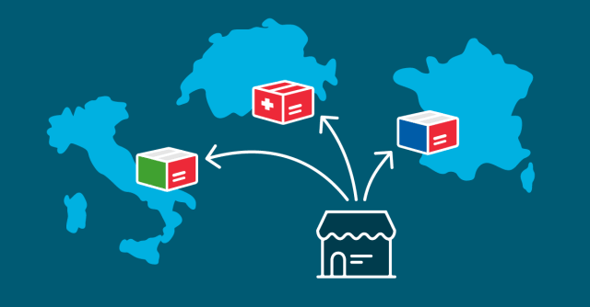Will pick-up points replace front door delivery in perspective? How can shipping be made more environmentally friendly? What are the advantages of time-window solutions?
Martin Wunderlich is Head of Parcel Logistics and Operations at Seven Senders. In our interview, he summarizes his experiences in cross-border shipping and shows why it pays to work with a network of different carriers.

Martin, as Head of Parcel Logistics and Operations, you and your team will accompany online shops during international product shipping. In your experience, what is currently moving the last mile?
Scarce delivery capacities in local networks, a shortage of drivers and personnel or the necessary modernisation of existing infrastructures – all these topics are currently very present in logistics. Due to the continuous growth of online trade, the industry is facing major challenges that require new strategies.
On the market, voices are becoming increasingly louder to regard door-to-door delivery as a premium service – in contrast to pick-up and drop-off points as a standard delivery option. This concept has been very popular for several years, especially in the Scandinavian countries, because it reduces the number of journeys compared to classic door-to-door delivery and optimises the delivery rate. Ideally, we are talking about one delivery attempt and not two to three.
Everywhere the call for environmentally friendly shipping solutions is getting louder. It remains to be seen whether pickup stations will even be offered as a preference by most carriers in the future and overtake front door delivery. But I can well imagine that they will change the last mile, in Germany and throughout Europe.
Which shipping methods do online merchants still use to reduce their own CO2 emissions?
This can be controlled, for example, by selecting the right carriers. More and more shipping service providers are developing innovative concepts for last mile delivery, for example delivery with electronic vehicles. Personally, I also find time-window deliveries very interesting: customers choose their own delivery date for front door delivery and are reminded of this at regular intervals. So suppliers don’t run the risk of going to an address for nothing.
In Sweden, there is even a carrier that sends its customers a photo of the driver and his name at a certain time, so consumers know who is at the door late in the evening. We are very close to the markets and the shipping solutions in order to provide our customers with the right shipping solutions for their target groups.
More than half of all online merchants today work with different shipping service providers. What are the benefits?
This strategy is suitable both for domestic shipping and for expanding online shops that ship across national borders.
Cross-border shipping requires a local carrier strategy. Looking at the European carrier landscape, it quickly becomes apparent that only a few internationally active CEP providers have their own logistics network covering all European countries. In practice, this means that these providers, however well they are positioned internationally, cannot compete with regional market leaders in terms of the quality of their services (as of October 2019).
An example: Pick-up points 50 kilometres away from the end customer no longer put a smile on anyone’s face. It is therefore logical that many shop suppliers work with different local carriers to offer their customers the best service. Building on this, a multi-carrier strategy can be used to expand even further in order to further optimise the last mile: Not every carrier is comparably good in every region and it is therefore worth combining the strengths of different providers. Dealers also have the option of selecting the best CEP provider on the basis of postal codes, or of targeting parcels on the right carrier depending on size and weight.
What is important when choosing the right shipping service provider?
For the ideal multi-carrier approach, cooperation with several carriers is recommended:
-
- offer the desired services (e.g. PUDO, express shipping, sustainable solutions),
- ideally match your own shipment structures,
- help to keep and deliver their own customer promises on time like local market leaders,
- enjoy a high level of acceptance among the population,
- and deliver the desired quality.
When it comes to expanding the online shop: What is the best way for online retailers to plan their market entry in a new target country in order to ship successfully from the outset?
No matter how well an existing domestic shipping concept works: Copying it and simply translating it into the respective national language is not enough for a good customer experience. Before entering the market, online merchants should be clear about where they want to go. They need to know the individual markets well: What requirements do customers have? What are the current delivery methods? Which CEP providers are active in the market? How do the competitors act?
 “Before entering the market, online merchants should be clear about where they want to go.” Martin Wunderlich
“Before entering the market, online merchants should be clear about where they want to go.” Martin Wunderlich
Building up this knowledge and integrating it into a meaningful local and/or multi-carrier strategy naturally requires a lot of lead time and good planning. However, it is only on this basis that it is possible to decide which services will appeal to local customers.
In addition to market knowledge and the ideal carrier mix, clear and simple logistics processes are also essential to reduce the complexity of cross-border shipping and positively influence customer experience.
How do you support this project together with your team?
At Seven Senders, we also map country management in order to support our customers. Our team includes, for example, French- and Italian-speaking Logistics experts who are familiar with the culture and country-specific customs. We travel with these experts to the respective markets at regular intervals. There, for example, we visit our local service providers or industry-specific trade fairs – sometimes just to see what’s going on there.
We talk a lot with our local partners to find out what’s going on: How is the mood on the market, how popular are individual carriers and services at the moment? We then provide these market insights to online retailers in order to improve the customer experience and reduce overall complexity.
Speaking of complexity: Working with multiple carriers naturally also increases internal effort and costs. How do dealers manage to streamline cross-border shipping processes?
Deliveries, returns, claims, quality measurements, tracking customs regulations, invoices – all these issues naturally make the parcel business very complex. Thanks to a comprehensive network of international shipping service providers, e-commerce retailers can cover all the country-specific customer delivery preferences they require. When it comes to managing carriers, measuring their performance and talking to them about problem solving, a central shipping platform is the best way to reduce complexity.
 "Pick-up points 50 kilometres away from the end customer no longer put a smile on anyone’s face. It is therefore logical that many shop suppliers work with different local carriers to offer their customers the best service.” Martin Wunderlich
"Pick-up points 50 kilometres away from the end customer no longer put a smile on anyone’s face. It is therefore logical that many shop suppliers work with different local carriers to offer their customers the best service.” Martin Wunderlich
Together with my team we support our customers in all logistic processes: As the first point of contact for all issues relating to European parcel shipping, we share our market knowledge with customers to create and manage an individual multi-carrier mix for online retailers.
Thank you for the interview!